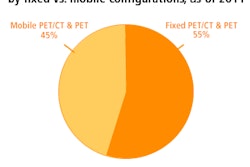PET developer Naviscan is touting the results of a study that found that positron emission mammography (PEM) has a higher sensitivity for tumor detection compared to whole-body PET/CT when using both visual and quantitative analysis.
The study, published in the October issue of the Breast Journal, comes from researchers at Seoul National University College of Medicine in South Korea.
A total of 113 breast lesions from 101 patients (with a mean tumor size of 2.2 cm) were included in the analysis. The patients underwent PEM with FDG and whole-body PET/CT before surgical resection; the images were then analyzed visually and quantitatively using the tumor to normal tissue uptake ratio, according to Naviscan.
In the visual analysis, the overall sensitivity of PEM was 95%, which was significantly greater than the 87% sensitivity found for PET/CT. The tumor to normal tissue uptake ratio of PEM was significantly greater than that of PET/CT in small tumors, Naviscan said.




















